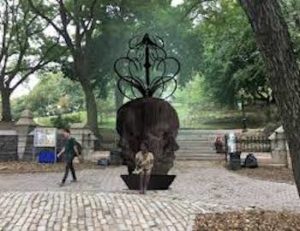
Fort Greene Park
*Fort Greene, NYC, is celebrated on this date in 1860. This diverse neighborhood is in the northwestern part of the New York City borough of Brooklyn.
As of 2010, the racial makeup of the neighborhood was 27.9% (7,289) White, 42.5% (11,081) African American, 0.3% (67) Native American, 7.3% (1,897) Asian, 0.0% (7) Pacific Islander, 0.3% (84) from other races, and 3.3% (857) from two or more races. The neighborhood is bounded by Flushing Avenue and the Brooklyn Navy Yard to the north, Flatbush Avenue Extension and Downtown Brooklyn to the west, Atlantic Avenue and Prospect Heights to the south, and Vanderbilt Avenue and Clinton Hill to the east. The Fort Greene Historic District is listed on the New York State Registry and the National Register of Historic Places and is a New York City-designated historic district.
The neighborhood is named after an American Revolutionary War-era fort built in 1776 under the supervision of General Nathanael Greene during the Battle of Long Island. Fort Greene Park, originally called "Washington Park," and Brooklyn's first is derived from General Greene's name and neighborhood. Since the early 19th century, Blacks have significantly contributed to Fort Greene's development. It is the birth home of Dr. Susan McKinney Steward.
New York State outlawed slavery in 1827, and 20 years later, "Colored School No. 1," Brooklyn's first school for Blacks, opened at the current site of the Walt Whitman Houses. Abolitionists formed the Lafayette Avenue Presbyterian Church in 1857, hosted speakers such as Frederick Douglass and Harriet Tubman, and aided in the Underground Railroad's work.
Skilled black workers fought for their rights at the Navy Yard during the tumultuous Draft Riots of 1863 against armed hooligan bands. The principal of P.S. 67 in the same year was African American, and Dr. Phillip A. White became the first black member of Brooklyn's Board of Education in 1882. By 1870, more than half of the Blacks in Brooklyn lived in Fort Greene, mostly north of Fort Greene Park.
Fort Greene is also home to the Brooklyn Academy of Music, the Brooklyn Music School, The Paul Robeson Theater, and The Museum of Contemporary African Diaspora Arts. Fort Greene contains many examples of mid-19th-century Italianate and Eastlake architecture, which are the most well preserved. It is known for its many tree-lined streets and elegant low-rise housing. Fort Greene is also home to the Williamsburgh Savings Bank Tower, which, for over 80 years, was the tallest building in Brooklyn. The neighborhood is close to the Atlantic Terminal station of the Long Island Railroad and has access to many New York City Subway services. Fort Greene is part of Brooklyn Community District 2, and its primary ZIP Codes are 11201, 11205, 11217, and 11238. The 88th Precinct of the New York City Police Department patrols it. Politically, it is represented by the New York City Council's 35th District.